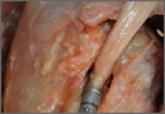Article

Biomechanical Evaluation of Two Arthroscopic Biceps Tenodesis Techniques: Proximal Interference Screw and Modified Percutaneous Intra-Articular Transtendon
- Author:
- Hartigan DE
- Beran MC
- Fleischli JE
- D'alessandro DF
- Zheng N
The percutaneous intra-articular transtendon (PITT) technique has recently been shown to have results comparable to those of more accepted...
